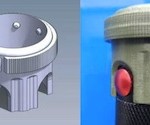Technology has always been a major influence on war. It has taken many forms from building automated weapons to transportation and distribution of supplies. This has further influenced how soldiers are trained, as the technicians behind the inventions rarely entered the battlefield. Thinking further ahead, as previously reported, battles of war might experience a change of nature if soldiers had access to technology that could make fast repairs and fixes, on the spot, using new technologies such as 3D printing.
The latest evolution in this field is the Expeditionary Lab Mobile (ELM), which allows fast problem solving from conception to implementation. The ELM is a 20-foot container, which is equipped with 3D printers, computer-assisted milling machines, laser, plasma, and water cutters, and some common tools such as saws and welding gear. The materials that can be used to construct parts consist of plastic, steel and aluminum. The ELM is designed to be operated by two specially trained engineers. It has a generator, heating and cooling systems, but also satellite communications.

The U.S. Army Rapid Equipping Force (REF) have deployed two ELMs in Afganistan, with the 3rd planned for June of this year.
Col. Peter Newell, the director of the REF, was in charge of the transformation of existing non-mobile prototyping labs in Afghanistan into the mobile versions. He commented on the need for the ELMs: “The soldiers out there, they know how to do stuff; they know how to fix stuff and they know what they need to be able to do, but what they don’t have is the technical expertise in many cases to do it themselves.”
The ELM labs were produced by Exponent Inc., an engineering consulting company, and they were part of a larger $9.7 million contract.
Have a look at the video to get more insight on how ELM can be used for the Army’s needs:
Afghanistan and battlefield applications is just the beginning for ELM. There are many other applications where ELM could be extremely useful. Think of a natural disaster, where the humanitarian efforts are often restricted by cut-offs in logistics. ELMs could provide immediate assistance and serve to produce supplies that are needed precisely when they are needed.
Source: SingularityHUB


